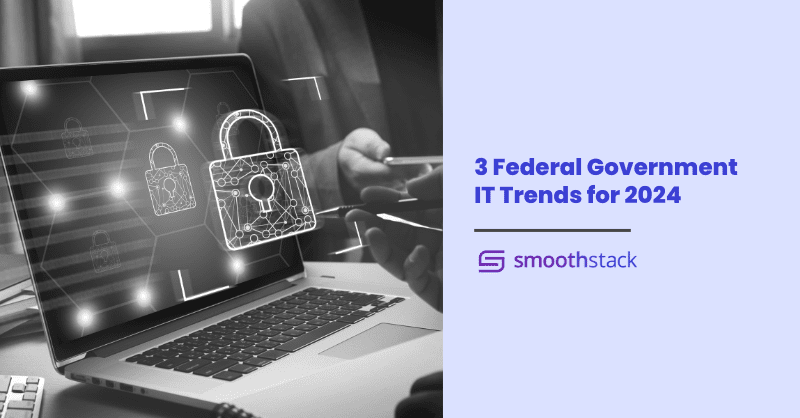3 Federal Government IT Trends for 2024

Today’s economic uncertainty is forcing the private sector to press pause on any non-critical digital projects. However, the public sector’s outlook is still very much “full steam ahead” when it comes to IT initiatives.
What are the biggest trends driving IT spending in the federal government space, especially since kicking off its new fiscal year in October? We dig into some of the recent headlines and research to compile a short list of priorities and areas of attention.
The highest priority: Cybersecurity
It’s not easy to keep pace with a moving target that only gets bigger, faster, and more dangerous. That’s the very real reality that all organizations are facing when it comes to cybersecurity. While it’s a top priority for public companies, the stakes are even higher for government agencies.
On the agenda in the year ahead? Finding and retaining the best cybersecurity talent. Standing in their way? A significant talent shortage. ISC2’s latest Cybersecurity Workforce Study, released last month, reported that the cybersecurity workforce shortage has hit a new record of just under 4 million.
Another layer to the talent shortage is the lack of cleared cybersecurity talent. Beyond the broader competition for talent, there’s now a sub-competition for this talent between government agencies.
Read more in this FedScoop article.
Not exactly as it seems: Generative AI
Generative AI is dominating the conversation right now when it comes to private business priorities for 2024. However, it’s a slightly different story when it comes to public organizations. While the promise of AI is appealing, in reality there are far more roadblocks to adoption.
A new survey from FedScoop polled government program and operations executives and IT and security officials. The top concerns related to generative AI are an inability to ensure ethical/responsible information generation, verify/explain generated output, and prevent abuse/distortion of government-generated content in the public domain.
The timeline to figure it all out is decidedly (and with good reason) slower than in the private sector. Nearly half of respondents said their agencies are planning to explore generative AI within the next 12 months. What must come first is putting parameters in place – 71% of respondents are working on developing AI policies and resources.
Check out the FedScoop report.
Up and coming: Composable government applications
There is no shortage of active IT modernization initiatives in the federal space. In 2023 we saw the introduction (or re-introduction) of the Legacy IT Reduction Act and the Modernizing Government Technology Reform Act of 2023.
In recent years we’ve seen legacy systems crash in both small and catastrophic ways. The Federal Aviation Administration’s system outage comes to mind, delaying over 32,000 flights. Not only are these systems not serving citizens well, but they’re incredibly costly: according to a GAO report, maintaining legacy systems accounts for about 80% of the federal government’s IT budget each year.
What exactly will these updated systems look like? Gartner predicts a focus on composability: “By 2024, more than 25% of government RFPs for mission-critical IT systems will require solutions architecture and variable licensing that support a composable design approach. This is compounded by our prediction that by 2025, eight of the top 10 application vendors will structure their application suite products as collections of composable business capabilities.”
Read more on Gartner’s website.
Smoothstack skills cleared, early-career talent who can help further the digital initiatives of government agencies. Visit our government page to learn how our Hire-Train-Deploy approach as the alternative to IT staffing partners and how it can reduce hiring friction and help public organizations reach their goals this year.
Let’s Build Your Team
Connect with the Smoothstack team to learn how to close your digital skills gap with a custom-trained team.